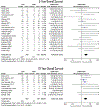Hyams grading as a predictor of metastasis and overall survival in esthesioneuroblastoma: a meta-analysis
- PMID: 31251848
- PMCID: PMC7276257
- DOI: 10.1002/alr.22373
Hyams grading as a predictor of metastasis and overall survival in esthesioneuroblastoma: a meta-analysis
Abstract
Background: Esthesioneuroblastoma (ENB), also known as olfactory neuroblastoma, represents up to 3% of all sinonasal neoplasms. Hyams histologic grading is a promising tool in predicting metastases and establishing prognoses for this complex tumor.
Methods: A systematic literature search was performed in the PubMed, Ovid MEDLINE, and Cochrane databases. ENB patients with Hyams I-II or III-IV were categorized as low-grade Hyams (LGH) or high-grade Hyams (HGH), respectively. Binary and continuous random-effects models were applied to calculate odds ratios (ORs) for the incidences of neck and distal metastases as well as for 5- and 10-year overall survival rates.
Results: Of the 57 screened articles published from 1993 to 2018, 16 (525 patients) and 21 (563 patients) provided data for tumor metastases and overall survival rates, respectively. Neck metastasis was observed in 18.2% of HGH vs 7.9% of LGH patients. Distant metastasis was noted in 20.7% of HGH vs 8.9% of LGH patients. LGH patients had 5- and 10-year overall survival rates of 81.2% and 64.0%, respectively, as compared with 60.9% and 40.6%, respectively, for HGH patients. In comparing HGHs vs LGHs, the collective ORs for neck and distant metastases were 2.08 (95% confidence interval [CI], 1.09-3.99; p = 0.03) and 2.37 (95% CI, 1.07-5.26; p = 0.03), respectively. Moreover, in comparing LGHs vs HGHs, collective ORs for 5- and 10-year overall survival rates were 3.39 (95% CI, 2.09-5.49; p < 0.001) and 3.03 (95% CI, 1.82-5.06; p < 0.001), respectively.
Conclusion: HGH ENBs, compared with LGH ENBs, are more likely to metastasize to neck or distal targets and to have lower overall survival rates.
Keywords: esthesioneuroblastoma; meta-analysis; metastasis; olfactory neuroblastoma; survival.
© 2019 ARS-AAOA, LLC.
Conflict of interest statement
Figures




References
-
- Berger L. L’esthesioneuroepitheliome olfactif. Bull Assoc Fr Etud Cancer. 1924;13:410–21.
-
- Barnes L, Eveson JW, Reichart P, Sidransky D, editors. Pathology and genetics of head and neck tumours. Vol 9 IARC; 2005.
-
- Bradley PJ, Jones NS, Robertson I. Diagnosis and management of esthesioneuroblastoma. CURR OPIN OTOLARYNGO. 2003. April; 11(2):112–8. - PubMed
-
- Broich I, Pagliari A, Ottaviani F. Esthesioneuroblastoma: a general review of the cases published since the discovery of the tumour in 1924. Anticancer Res. 1997;17:2683–706. - PubMed

